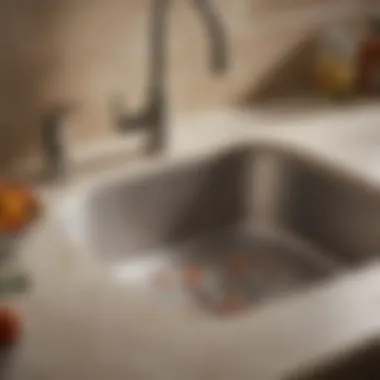Effective Strategies for Cleaning Your Sink's Garbage Disposal


Intro
Having a clean and properly functioning garbage disposal can make a world of difference in your kitchen. It keeps unpleasant odors at bay, prevents clogs, and ensures that food waste is processed efficiently. Ignoring this vital appliance not only leads to discomfort in the culinary space but might also create an unhealthy environment.
Cleaning your sink's garbage disposal isn’t merely about aesthetics; it’s about maintaining overall hygiene and performance. Many people might think that running water and a few scraps of food are enough to keep the disposal clean, but that couldn't be further from the truth. Over time, residue can build up, leading not only to bad smells but also to potential mechanical issues.
This guide aims to equip you with practical strategies, tools, and straightforward instructions to effectively clean your garbage disposal. It’ll touch upon the importance of regular maintenance, tackle common issues, and offer preventive measures. By the time you're done reading, you'll be set to elevate your kitchen care practices.
So, roll up your sleeves and let’s dive deep into the nitty-gritty of maintaining that invaluable kitchen helper.
Understanding Garbage Disposals
Understanding garbage disposals is fundamental for any homeowner aiming to maintain a clean and efficient kitchen environment. A garbage disposal is not just a handy appliance; it is a crucial part of your kitchen's waste management system. By grasping its functioning, benefits, and potential drawbacks, one can make better use of this tool while also ensuring its longevity and effectiveness.
The convenience of a garbage disposal lies in its ability to reduce food waste significantly. Instead of tossing scraps in the trash, which can lead to odors and attract pests, you can simply grind them up and wash them down the drain. This process helps in keeping your kitchen cleaner and reduces the amount of food waste sent to landfills. Moreover, understanding how to clean and maintain your disposal will allow it to work effectively, thus enhancing your overall kitchen hygiene.
With that said, it is also important to be aware of the limitations and risks associated with garbage disposals. Misuse can lead to jams, clogs, and even equipment failure, which can result in costly repairs. The better you understand your garbage disposal, the better decisions you'll make regarding what to put down it, and how to clean it properly.
What Is a Garbage Disposal?
A garbage disposal is a device installed under a kitchen sink that shreds food waste into small pieces, allowing it to be washed away through the plumbing. Usually hardwired to the sink's electrical supply, garbage disposals work by rotating a set of blades that grind the food into tiny bits, making it easier for it to pass through the drain. They commonly come with a powerful motor that ensures that even tougher scraps can be processed effectively.
In practical terms, a garbage disposal eliminates food waste before it can rot and create unpleasant odors. This also leads to a cleaner kitchen overall. Most models can handle a variety of scraps, including vegetable peels, fruit skins, and small amounts of meat.
Nevertheless, it is essential to understand that not everything should go down the disposal. Things like bones, fibrous vegetables, and oily foods can cause clogs or jam the blades, so knowing what your disposal can handle is crucial.
How Does It Work?
Garbage disposals operate through a mechanical process that involves several key steps. When you turn on the disposal — either via a switch or button — electrical power is sent to the motor. Here's a simplified breakdown of the workings:
- Grinding Mechanism: Once the motor is energized, it begins to spin a plate called an impeller. This action draws food waste into the grinding chamber, where it meets a system of sharp blades that chop and shred the waste into smaller particles.
- Water Flow: As the grinding progresses, water is typically run into the disposal to help wash down food particles. The water aids in flushing the ground waste through the plumbing system effectively.
- Discharge: Once ground, the waste exits the disposal unit and moves into your home's drainage system, eventually reaching the wastewater treatment facility.
Understanding how a garbage disposal works can help you utilize it properly, reducing issues related to jams and ineffective waste management.
Being aware of this process highlights the importance of what you put down your disposal. By knowing the mechanics behind it, one can appreciate the engineering that allows it to function and makes better choices regarding food waste disposal.
Importance of Cleaning
Cleaning your garbage disposal is not something many people think about until they face a nasty smell or poor performance. Yet, ensuring that this kitchen appliance remains in top-notch shape is crucial for several reasons. The importance of cleaning your sink's garbage disposal lies in maintaining both health standards and optimal functionality, thereby creating a cleaner and more pleasant kitchen environment.
Health Risks of a Dirty Disposal
When it comes to health, a dirty garbage disposal can be a breeding ground for bacteria. Food residues left to rot can attract all sorts of bacteria and pests. According to studies, areas that aren’t regularly cleaned can harbor pathogens that can lead to foodborne illnesses. When you grind scraps, bits of food might escape into the hard-to-reach corners, creating a potential health hazard.
Just as you wouldn’t let unwashed dishes sit for days, overlooking the garbage disposal could lead to some unsavory consequences. Regular cleaning keeps things from festering, ultimately contributing to a healthier home.
Remember, hygiene starts at home. A well-maintained disposal not only reduces risks but elevates your overall kitchen safety.
The need for cleanliness is not merely a matter of aesthetic appeal; it significantly impacts food safety. Infected food scraps don't just affect the disposal; they can also transfer harmful bacteria to other kitchen surfaces. So, the next time you use it, be aware of swarming microbes lurking in that neglected part of your kitchen.
Impact on Performance
Now, onto performance: the last thing you want is a sluggish garbage disposal. A clean disposal operates smoothly, efficiently grinding food waste and draining water without a hitch. If it's clogged with grime and food remnants, you’ll find that it's less effective at doing its job. This inefficiency could eventually lead to breakdowns or even more significant plumbing issues.
When you neglect cleaning, you’re essentially setting yourself up for a headache later. Over time, increased wear and tear will curtail the lifespan of your garbage disposal, leading you to shell out money on repairs or even replacement.
Some common performance issues caused by neglect include:
- Increased machine noise due to strain
- Slower drainage times
- Frequent clogs requiring professional help
By committing to a regular cleaning schedule, you're not only improving the lifespan of your appliance but also ensuring that it works as effectively as when it was first installed. Cleanliness isn’t just next to godliness; it’s also the key to a functional kitchen.
In summary, overlooking the maintenance of your garbage disposal opens the door to health hazards as well as declining performance. Prioritize cleaning to enjoy a long, hassle-free life for this essential kitchen device.
Common Issues with Garbage Disposals


Garbage disposals are often the unsung heroes of the kitchen. They deal with a myriad of food scraps and waste that would otherwise clutter our sinks and cabinets. However, they can encounter a few hiccups along the way, which can lead to frustration or, in some cases, significant issues in your kitchen. Understanding common problems with garbage disposals is crucial for regular maintenance and ensuring these appliances continue to function smoothly. This section dives into the three prevalent issues: odors, jams, and unusual noises. By recognizing these problems early, you can often prevent more extensive damage and costly repairs.
Common Odors
One of the more unsettling experiences any home cook can face is opening the disposal only to be greeted by an unpleasant odor. Food particles that get stuck can lead to decomposition, resulting in a less-than-pleasant smell wafting through the kitchen. It's crucial to be mindful of what goes into the disposal.
Here are a few key points to consider:
- Food Scraps: Some items, such as fibrous vegetables (like celery) and starchy foods (like rice), can cause buildup and should be avoided in excess.
- Cleaning Routine: Regular cleaning can be a game changer. Using natural deodorizing agents, like baking soda or citrus peels, can drastically improve overall odor.
- Water: Always run cold water for at least 30 seconds after using the disposal to help flush out remaining particles.
"If you can smell it, chances are your disposal needs a good cleaning."
Jams and Clogs
A jam is another prevalent issue and can really put a wrench in your kitchen operation. Disposals can easily jam due to the types of food being disposed of or overloading. If your disposal begins to act up, knowing how to troubleshoot can save you time and even a service call.
Some common causes of jams include:
- Excess Scraps at Once: Sending too much down at a time can overwhelm the system.
- Improper Items: Non-food items, like utensils or rubber items, must never be tossed in.
- Fat and Grease: These can solidify in your pipes and cause severe clogs that even your disposal may not be able to manage.
Unusual Noises
Lastly, if your garbage disposal begins to emit strange or loud sounds, it might be trying to tell you something. Unusual noises can indicate the presence of foreign objects that shouldn't be there or mechanical issues that may need attention.
Listen for:
- Grinding Noises: This could mean hard objects or ice are stuck inside, which isn't good for the blades.
- Humming Sounds: If the disposal hums without spinning, something is likely jammed, and you will need to investigate.
- Rattling: This could mean loose parts inside that might need to be tightened or replaced.
In summary, keeping tabs on these common issues can help you maintain your garbage disposal effectively. By being proactive, you ensure that your kitchen stays clean, fresh, and efficient.
Tools Required for Cleaning
When it comes to sprucing up your sink's garbage disposal, having the right tools on hand makes the process flow smoother than good old-fashioned peanut butter. Whether you're tackling grunge or simply giving it a well-deserved shine, the proper supplies are the backbone of a successful cleaning venture. Gathering your tools in advance means you'll save time, avoid frustration, and finish stronger than a well-brewed cup of coffee. Here, we'll break down the essentials and elements to consider.
Basic Cleaning Supplies
To kick off your cleaning session, it’s vital to arm yourself with basic supplies that cover every nook and cranny of the disposal. Here are some key players that shouldn’t be missing from your toolkit:
- Dish Soap: A good quality dish soap works wonders. It cuts through grease like a hot knife through butter.
- Mitten or Sponge: Having a sturdy sponge or a clean dish mitt can be invaluable. It allows you to scrub away grime without getting your hands too dirty.
- White Vinegar: This not only deodorizes but also disinfects the disposal. It’s nature’s magic elixir that fights bad odors and stubborn residues.
- Baking Soda: An unsung hero in the cleaning world, it’s particularly effective in absorbing moisture and neutralizing odors.
- Scrub Brush: A brush with stiff bristles can get into crevices that sponges might miss, ensuring a thorough clean.
This basic kit forms a solid foundation for tackling any unwanted build-up, allowing you to shine that disposal bright. However, keep in mind that these items are merely the tip of the iceberg.
Protective Gear
Never underestimate the importance of safeguarding yourself while diving deep into your garbage disposal. Though it might not seem like a particularly hazardous activity, chemical reactions and hidden junctions can lead to unfortunate accidents if you're not careful. Investing in protective gear can prevent those mishaps from occurring.
Some essentials to consider include:
- Rubber Gloves: These will keep your hands clean and shield you from any harsh cleaning agents. Plus, they offer a good grip when you're working with slippery surfaces.
- Safety Goggles: Protecting your eyes is paramount, especially if you're using vinegar or baking soda for an intense clean. These reactions can get lively!
- Old Clothes: Rather than donning your Sunday best, throw on something you don’t mind getting a little dirty. You never know when an errant splash or spill might occur.
Applying these basic protective measures can help you navigate the cleaning process confidently. In the same way that a chef wouldn’t head to the kitchen without a sharp knife, you shouldn’t tackle the task of cleaning without the right safety gear in place. After all, nothing ruins a good dinner like a nasty cut or unexpected splatter.
Remember, taking a few moments to gather your tools and gear will pay off, letting you focus on making your garbage disposal shine.
Step-by-Step Cleaning Process
Cleaning your garbage disposal is not just a chore; it’s a fundamental practice for anyone who loves cooking and appreciates a pristine kitchen environment. A clean disposal not only helps in preventing foul odors, but it also maintains the efficiency of your disposal unit.
A thorough cleaning process can uncover hidden grime and deterioration that, if left unattended, could lead to more significant issues down the line. Consider it akin to regular maintenance on a car; neglect can lead to costly repairs and inconveniences. So, roll up your sleeves and let’s get down to the nitty-gritty!
Preparation and Safety Measures
Before diving into cleaning, preparation is key. First off, turn off your garbage disposal to ensure safety. This step is paramount; it protects you from any unintentional contact with a spinning blade or electrical mishap.
- Gather Your Supplies: You'll need some common household items like dish soap, a brush, and a cloth. These items are likely already in your home, making them readily available for an impromptu cleanup.
- Protective Gear: Always consider wearing gloves to protect your hands from sharp objects or substances. If you have a mask, it’s good to wear one, especially if you’re sensitive to odors or want to avoid any dust that might arise during cleaning.
- Ready the Area: Clear the sink area of any dishes or debris. A clean workspace ensures you're not scrambling for space or accidentally causing a mess while you clean the disposal.
Cleaning the Disposal Interior


Once you're all set up, it’s time to focus on the interior of the disposal. This area can harbor a breadth of food particles and grime that are not visible at first glance.
- Start with Soap and Water: Mixture of warm water and dish soap can be poured down into the disposal. Let it sit for a few minutes; the soap works to break down any stubborn grease or residue.
- Scrub the Inside: Using a long-handled brush, scrub the inside walls of the disposal gently. This part can feel a bit tedious but trust me; it’s rewarding to see the soap lather separate the gunk from the metal.
- Rinse Thoroughly: Run cold water through the disposal to flush away the dirty mixture. Ensure to keep the water flowing to thoroughly rinse the interior.
Using Ice and Salt
Here’s a tip that might not be in mainstream cleaning guides: using ice and salt can give your disposal a refreshing cleanse. While this might sound odd, it provides a fantastic scrubbing action without the use of harsh chemicals.
- Fill with Ice: Pour a couple of cups of ice into the disposal. This is where the magic starts to happen. The ice, when blended with the blades, scrubs the internal parts while they spin.
- Add Salt: Follow the ice with a generous sprinkle of coarse salt. The salt acts as an abrasive, effectively helping to dislodge any stubborn particles.
- Run the Disposal: Turn on the disposal and let it chop up the ice and salt mixture. You’ll notice a satisfying crunching as it works its magic. This process creates a refreshing splash of cold water on the blades, enhancing the cleaning effect.
Keeping your garbage disposal clean is crucial not only for hygiene but also for its longevity. A clean disposal is a happy disposal!
Now that you’re equipped with a detailed step-by-step guide, you can maintain a healthy garbage disposal system. Make cleaning a routine, and you will enjoy both the functionality and cleanliness of your kitchen workspace.
Odor Elimination Techniques
A stinky garbage disposal can turn the most appetizing kitchen into a less-than-desirable cooking space. Odor elimination is not just about freshening up your kitchen; it's about maintaining hygiene and preventing potentially harmful bacteria from thriving in your disposal. Understanding the causes of odor and implementing effective techniques to combat it is crucial. This section will cover natural and commercial methods available for eliminating unpleasant smells from your sink's garbage disposal.
Natural Deodorizing Agents
Using natural deodorizing agents is an excellent way to freshen up your garbage disposal without resorting to harsh chemicals. These made-at-home remedies often utilize familiar ingredients that you may already have in your kitchen. Here are a few of the most effective natural options:
- Baking Soda and Vinegar: This classic combo works wonders. Pour half a cup of baking soda followed by half a cup of vinegar into the disposal. Let it fizz for about ten minutes, then rinse with hot water. This reaction effectively loosens grime and neutralizes odors.
- Lemon or Lime Peels: Citrus is a natural deodorizer. Toss peel pieces down the disposal and run it while the water is flowing. The fresh scent will cut through the stale odors while the acidity helps break down any lingering organic matter.
- Salt and Ice Cubes: If you’ve got some ice cubes left over from your last party, they can come in handy. Mixing salt with ice cubes can help scrape away gunk without damaging the disposal blades. The coolness followed by a hot water rinse leaves a fresh scent.
- Coffee Grounds: They can be a mixed bag, but a little goes a long way. Your used coffee grounds can absorb and eliminate odors. Just toss a tablespoon down the disposal, run the water, and let them do their work.
These natural agents are not only effective but also eco-friendly, making them appealing choices for enthusiasts of sustainable cooking.
Commercial Deodorizing Products
While natural methods work well, sometimes a stronger approach is needed to tackle persistent odors. This is when commercial deodorizing products can really shine. They are specifically formulated to target the source of unpleasant odors in a more potent way. Here are some tried-and-true options:
- Garbage Disposal Cleaner Tablets: These convenient tablets usually contain enzymes that break down food particles and eliminate odors. Just drop one in, run the disposal, and let the product do the work.
- Citrus-Based Liquid Cleaners: These cleaners are designed specifically for garbage disposals. They often come in scented varieties that not only neutralize odors but also freshen the whole area with a pleasant scent.
- Essential Oil Drops: While not strictly commercial, essential oils can be an effective deodorizer. A few drops of peppermint or eucalyptus oil in the disposal can provide a refreshing scent and combat foul smells at the same time.
- Biodegradable Deodorizing Sprays: Some brands offer sprays designed to neutralize odors without harsh chemicals. Spray a bit into the disposal and let it sit to tackle lingering smells.
Ultimately, whether using natural ingredients or opting for commercial solutions, the goal remains the same—maintaining a fresh and clean garbage disposal not only enhances kitchen ambiance but also promotes hygiene throughout your home.
Important Note: Regularly integrating odor elimination techniques into your cleaning routine can keep troublesome smells at bay and ensure your disposal remains an effective tool in your kitchen arsenal.
Regular Maintenance Schedule
A well-maintained garbage disposal not only helps keep your kitchen tidy but also extends the life of the unit, reducing the need for costly repairs down the road. Establishing a regular maintenance schedule is fundamental. This means picking a rhythm for those cleaning tasks and sticking to it. Having this in place enables you to prevent issues before they even start, keeping your disposal in tip-top shape.
Daily Practices
Engaging in simple daily practices can make a significant difference in maintaining your garbage disposal. Here are some quick tips:
- Rinse After Use: After every meal preparation, run warm water through the disposal while it’s in operation. This helps wash away any leftover food particles that might cling to the blades or walls of the unit.
- Use a Lemon or Lime: Toss in a few citrus peels while running the disposal. Not only does it impart a fresh scent, but it also provides a bit of scrubbing action. This keeps odors at bay and the blades clean.
- Avoid Hard Foods: Be cautious about what you are throwing down the disposal. Items like fibrous vegetables or hard bones can lead to clogs or jams. Instead, use your disposal for soft food waste.
"A pinch of prevention is worth a pound of cure. Keeping up with daily practices saves more than time, it saves your system from breakdowns."
Weekly and Monthly Checks
Taking it a step further, adding weekly and monthly checks to your routine can help in spotting potential problems early. These checks are not extensive but can save you from bigger headaches later.
For weekly checks:
- Inspect for Odors: Take a moment to sniff around. If an odor seems to be lurking, it's a cue to give your disposal some extra attention.
- Run Ice Cubes: Running ice through the disposal while it's running can help dislodge any small debris caught on the blades.
For monthly checks:
- Deep Clean: Set time aside once a month to give your disposal a deeper clean. This might involve using baking soda and vinegar for a natural cleaning, allowing it to sit, and then rinsing it out.
- Check for Leaks: Inspect the area under the sink for signs of leaks. If your disposal is leaking, it’s best to address it immediately.
Incorporating these practices into your routine keeps your garbage disposal functioning efficiently and helps to create a fresher kitchen environment. The key is consistency. As the old saying goes, "A stitch in time saves nine." Regular maintenance prevents problems before they escalate.
When to Seek Professional Help
Understanding when to reach out to a professional can save not just time but also your sanity. Many homeowners might think they can tackle every issue that arises with their garbage disposal; however, some situations require the expertise of someone who knows their way around this kitchen appliance. Recognizing the signs of a serious problem is crucial to keeping your kitchen running smoothly.


Identifying Serious Issues
Not all problems with your garbage disposal are easily fixable. If you notice certain signs, you may need to hit pause on your DIY ambitions and consult a pro. Here are key indicators:
- Frequent Jamming: If you find your disposal jamming regularly despite your efforts, there may be an underlying issue, such as faulty blades or a malfunctioning motor.
- Persistent Odors: Unpleasant smells that won’t go away could suggest food waste buildup somewhere that you can’t reach.
- Leaking Water: If you see water pooling under your sink or hear dripping sounds, that’s a clear signal that something’s wrong.
- Loud Noises: Strange grinding or clanking sounds can indicate that foreign objects are lodged inside, which might not be safe to remove on your own.
Experiencing one or more of these issues often points to deeper problems that could worsen over time.
Choosing a Service Provider
Once you’ve determined that professional help is needed, the next step is finding the right service provider. Not every repair service is created equal; you want someone who knows garbage disposals inside and out. Consider these factors when making your choice:
- Reputation: Check reviews or ask neighbors for recommendations. A company with a solid track record is usually a smart bet.
- Licensing: Always choose certified technicians who have the required qualifications and licenses to perform the repairs.
- Transparency: A trustworthy service provider will be clear about pricing and what the repair involves. They should provide a detailed estimate before starting any work.
- Availability: Look for a provider that offers flexible hours. Many issues can’t wait until Monday, especially if your kitchen is rendered unusable.
Environmental Considerations
In our modern world, where environmental issues grab headlines and stir up conversations, understanding the impact of everyday appliances like garbage disposals becomes crucial. These machines are often seen as mere conveniences, facilitating the quick disposal of food scraps. However, they play a more complex role in waste management that deserves careful examination. Cleaning and maintaining your sink's garbage disposal isn't just about hygiene and efficiency; it intersects with broader environmental considerations that have practical implications.
Effect on Waste Management
Garbage disposals are assigned a dual role: they assist in the breakdown of food waste while also influencing the larger waste management ecosystem. When food scraps are ground up, they are typically transported through the plumbing system and end up in wastewater treatment plants. Therefore, a well-maintained disposal can reduce the volume of solid waste that would otherwise clog landfills. This shift can lead to a happier planet overall.
"By keeping your disposal clean, you not only prolong its life but also contribute to a more efficient waste system."
Yet, it isn’t all rainbows and butterflies. Overloading or improperly using a garbage disposal can strain municipal sewage systems. For example, fibrous vegetables, bones, and large amounts of oil can lead to clogs that require more significant energy and resources to fix. Awareness of what goes down the disposal, coupled with regular cleaning, is the first step toward mitigating these negative impacts.
Sustainable Practices
Sustainability is more than a buzzword; it's a lifestyle choice that extends to how we manage kitchen waste. Integrating sustainable practices while using your garbage disposal can substantially benefit the environment. Here are some initiatives one might consider:
- Mindful Usage: Use the disposal wisely by only sending small amounts of compatible food waste down it. Educate yourself about what can and cannot be processed.
- Composting: Instead of relying solely on your disposal, consider composting organic waste like fruit peels and vegetable scraps. This practice not only minimizes your use of the disposal but enriches your garden soil as well.
- Regular Cleaning: Regular cleaning of the disposal ensures its efficiency, reducing the chances of failure and prolonging its lifespan, which is crucial in avoiding the production of more waste from replacements.
By adopting a synthetic approach, where garbage disposals serve as just one part of a more significant waste management strategy, individuals can play their part in creating a cleaner, greener world. Sustainable practices in the kitchen can ripple out into larger environmental benefits—each small step counts and adds up over time.
Innovations in Garbage Disposal Technology
As we dive into the realm of garbage disposal technology, it’s crucial to understand how innovations in this field are reshaping kitchen functionality. These advancements not only enhance the performance of disposals but also contribute significantly to environmental sustainability and user convenience. With kitchens being the heart of the home, keeping them efficient and odor-free is ever important. Newer models come equipped with features that can make the cleaning process easier and more effective for everyone, from everyday cooks to seasoned chefs.
Smart Garbage Disposals
Smart garbage disposals are a stride into the future of kitchen technology. Designed with connectivity features, these units enable users to monitor and manage their disposals directly from their smartphones. Imagine being able to check your disposal's operational status while lounging on the couch or receive notifications about maintenance reminders; that’s the convenience smart disposals offer.
- Voice Activation: Some models offer options for voice control, making it easy to operate with just a simple command, which is a huge plus when your hands are full.
- Leak Reporting: They can detect leaks and send alerts, minimizing the chance of potential water damage.
- Usage Tracking: Advanced features may include tracking the amount of waste being processed, helping in managing kitchen waste more effectively.
These technological upgrades help in prolonging the lifespan of the disposal and ensuring that users are less likely to encounter issues like jams and clogs. The user experience is becoming smoother, offering more peace of mind than older units could ever dream of.
Energy-Efficient Models
Moving towards energy-efficient models is not just a trend; it’s a responsible choice for the environment. These units use less energy while maintaining performance, which correlates to a reduced utility bill — a win-win situation for the household budget. Additionally,
- Eco-Friendly Design: Many energy-efficient disposals are designed with materials that minimize environmental impact, promoting recycling and sustainability.
- Lower Sound Levels: These models are often quieter during operation, which adds to the overall comfort of the kitchen experience.
- Smart Sensors: Some come equipped with smart sensors that adjust settings based on user needs, optimizing energy consumption.
By selecting an energy-efficient disposal, one not only helps the planet but can also enjoy significant savings over time. It is a simple yet impactful way to contribute to a greener future while enjoying modern conveniences.
"Investing in innovative home technologies like smart and energy-efficient disposals not only enhances kitchen hygiene, but also promotes a more sustainable way of living for generations to come."
Incorporating these innovations into your kitchen can shift the dynamics of waste management, creating a more harmonious and functional culinary space. As technology continues to evolve, staying informed about these advancements ensures that you are making the best decisions for your home and the environment.
Closure
Cleaning your sink's garbage disposal is not just about keeping your kitchen tidy; it directly influences your kitchen's hygiene and functionality. A clean disposal system prevents the accumulation of bacteria, reduces unpleasant odors, and helps your appliance to run smoothly. Regular maintenance ensures that your disposal works efficiently and prolongs its lifespan, which translates to savings in repairs or replacement costs down the line.
Recap of Key Points
In this guide, we have examined several essential aspects related to maintaining your garbage disposal:
- Understanding what a garbage disposal is and how it works can help you appreciate its role in kitchen hygiene.
- Cleaning your disposal regularly is vital for reducing health risks and ensuring it operates at peak performance.
- By recognizing common issues like odors, jams, and strange noises, you can address problems before they escalate.
- Familiarizing yourself with the necessary tools and supplies can make the cleaning process straightforward.
- Setting a regular maintenance schedule can keep your disposal in optimal condition without much effort.
- We discussed when it's appropriate to seek professional help, as certain issues can be beyond your capabilities.
- Finally, we've explored the environmental considerations associated with garbage disposals, emphasizing sustainable practices.
Final Thoughts on Maintenance
Thinking about your kitchen's garbage disposal shouldn't be a once-a-year chore. Just as you wouldn't allow dust to gather in the corners of your home, neglecting your disposal can lead to bigger troubles. A bit of routine upkeep can go a long way.
Ultimately, the maintenance of your garbage disposal is tied to the greater health of your kitchen. Embrace the small practices of daily or weekly inspection, and you'll maintain a fresh and functional environment. Whether you're a novice or a seasoned chef, integrating these practices into your routine will not only help maintain efficiency but also foster an overall sense of cleanliness and comfort in your culinary space.















